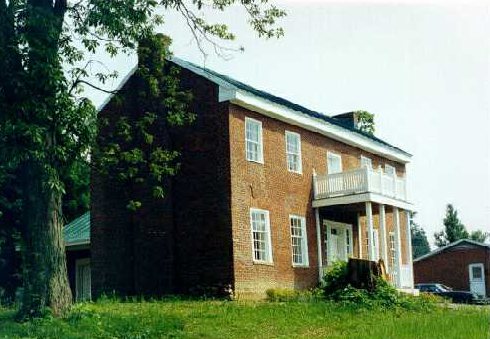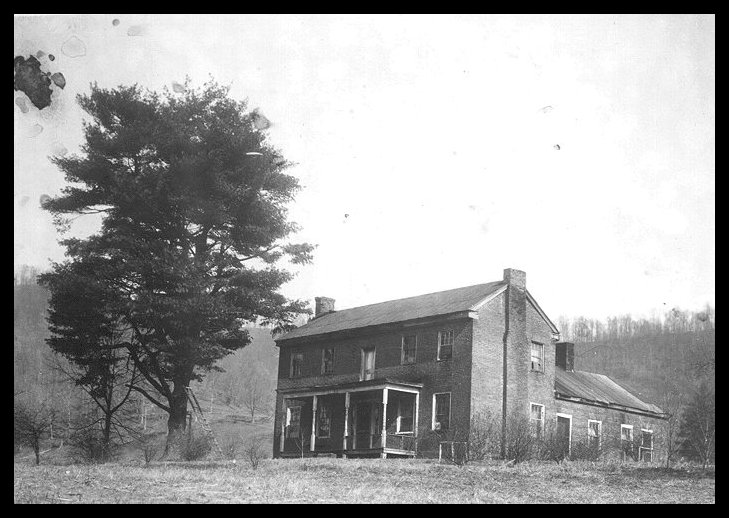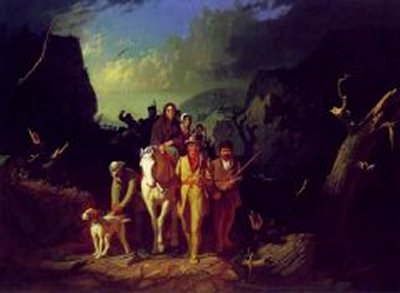 |
 |
 |
 |
 |
 |
 |
 |
 |
 |
 |
 |
 |
 |
 |
 |
 |
 |
 |
 |
 |
 |
 |
 |
 |
 |
 |
 |
 |
 |
 |
 |
 |
 |
 |
 |
 |
 |
 |
 |
 |
 |
 |
 |
 |
 |
 |
 |
 |
 |
 |
 |
 |
 |
 |
 |
 |
 |
 |
 |
 |
 |
 |
 |
 |
 |
 |
 |
|
|
The Oldest House in the Valley |
|
|
|
 |
|
|
Chapter One: The Mays of Shelby Creek |
|
|
|
|
|
|
 |
|
|
|
 |
|
|
|
The May House in North Prestonsburg, Kentucky, built by Samuel May in 1817, is the oldest brick home in the Big Sandy Valley. A century ago it was the hub of a three-hundred-acre farm, and, from its little knoll, commanded a view of green meadows, herds of cattle, and fields of corn and wheat. Today it overlooks a shopping mall and the green campus of Prestonsburg Community College. In her essay about the house, the late Josephine Davidson Fields called it Floyd County's Old Kentucky Home, pointing out that its style of architecture, Federal or Georgian, is the same as Federal Hill, the John Rowan House in Bardstown, which, by the way, it antedates by one year. It is six years older than its twin sister, the William Conner House, the two-million-dollar centerpiece of Conner Prairie Village in Indianapolis. |
|
|
|
|
Samuel May (1783-1851) was one of the pioneer builders of Floyd County. By turns a carpenter, surveyor, contractor, ferryman, innkeeper, farmer, justice of the peace, gold prospector, and politician, he built the county's first permanent courthouse, established one of its first saw and grist mills, and, from 1832 to 1839, represented the county in the state legislature. He was also the first Floyd Countian to sign a contract involving the development of coal. |
|
|
|
|
|
|
In 1842, having overextended himself, Samuel deeded the May Farm to his brother, Thomas May (1787-1867), one of the founders of Pike County, after Thomas paid off his mortgage and saved him from bankruptcy. Since 1842, except for a brief period, the house has remained in the hands of Thomas May's descendants, including William James May (1819-1883), Johnny Powers May (1872-1959), and Elijah Brown May (1896-1958). Until recently it was owned by the latter's two sons, William H. May and E. B. May, Jr. In addition to these men, other prominent Floyd Countians have lived under its roof, including Colonel Andrew Jackson May (1829-1903); one of the region's leading Confederate officers during the Civil War; Beverly Clark May (1856-1929) County Judge from 1913 to 1917; and Leonidas Polk May (1865-1951), County Sheriff from 1910 to 1914. |
|
|
|
In 1997, the Samuel May House was restored by its new owner, the City of Prestonsburg, using a $400,000 grant from the Kentucky Transportation Cabinet and the Kentucky Heritage Council. At right is a photo showing how the house looked in 1936. For a larger picture, click here. |
|
|
|
 |
|
|
|
|
|
Samuel May wasn't the only man with the May surname to settle in Floyd County, and as a consequence, the May family has many local branches. Newcomers should be careful not to confuse the above-mentioned Colonel Andrew Jackson May with Representative Andrew Jackson May (1875-1959), this region's Congressman during the Roosevelt years. One of Kentucky's most important power-brokers in his day, A. J. May was the grandson of Samuel May's brother Reuben May (1800-1840), one of the first settlers on Beaver Creek and the progenitor of the Maytown Mays. Furthermore, the branch of the family headed by Caleb May (1781-1827), an early settler of Magoffin County, is separate from Samuel's and Reuben's branch and should not be confused with it. |
|
|
|
Because of its unique status as the county's first two-story brick residence, and because of the prominence of the Samuel May family in early Prestonsburg, the May House was the center of Floyd County social life during the early years. Local beaux and belles danced the Virginia Reel in its ballroom, local gentry savored roast beef in its dining room, thoroughbreds raced before cheering crowds in its meadows, and politicians delivered speeches from its balcony. Today, for the historian, the house provides a locus, a starting point from which he can survey the local past, chart its principal features, and lay out roads of access to it. |
|
|
|
Samuel May was the second oldest son of John and Sarah Phillips May, one of the pioneer families of Eastern Kentucky. Originally from Martinsburg, Berkeley County, Virginia, where they were married in 1780, John and Sarah tried their luck in East Tennessee before coming to this area. In the Spring of 1800 they sold their farm on Roane's Creek in Carter County and made a long and difficult journey through Pound Gap to Robinson Creek in present-day Pike County, bringing with them their six children, their livestock, and wagons filled with all their worldly possessions. George Caleb Bingham's painting of Daniel Boone Escorting Settlers Through Cumberland Gap gives us some idea of what the journey through Pound Gap must have been like. |
|
|
|
 |
|
|
|
In 1800 Robinson Creek was covered by old-growth poplar, oak, and other hardwoods, and when John and his family arrived, they faced the daunting task of carving a farm out of the wilderness. Samuel spent his young manhood on this farm before coming to Prestonsburg in 1804. |
|
|
|
|
|
Two May family genealogists, Fred T. May and Tress May Francis, have discovered many interesting facts about John May. In 1776, for example, he was living in the home of his uncle, Daniel May, located at the corner of Queen and Burke Streets in Martinsburg. In those days the town was a station on the Wilderness Road, a major route for migration from the Eastern Seaboard to frontier settlements in North Carolina and Kentucky. In October, 1776, the Virginia Assembly passed a bill providing funds for the raising of six battalions of infantry. Berkeley County was required to raise eighty-four men. One of those who volunteered for duty was John May, age seventeen. In December, 1776 John's regiment marched to New Jersey, where they witnessed the Battle of Long Island from the Jersey shore. They also watched General Washington and his men make their retreat across the Hudson. Gilbert Stuart's painting of Washington reminds us of the reverence with which men like John May viewed our nation's founder: |
|
|
|
In the Spring of 1779, John returned to Martinsburg and began his courtship of Sarah Phillips. They were married in March, 1780, after "publishing the banns" in a local church. In 1845, thirty-two years after John's death, Sarah applied for a widow's pension, and as part of her application, she gave a deposition detailing the facts of John's military career. Among other things, she recalled that golden day in April, 1779, when she had first laid eyes on her future husband. |
|
|
|
Out on an errand, she had seen two local boys, Jacob Orr and Jacob Pink, take John into Kinney's Tavern and treat him to a drink. When she asked another boy why they were celebrating, he told her that John had just returned from the Army. Sarah died in 1846 and is buried beside her husband in the William Keathley Graveyard on Shelby Creek. The graves are located in a grove of trees and marked by native headstones. One of the stones has the faintly legible inscription, "John May born..." Her inscription has disappeared. |
|
|
|
John May's service in the Continental Line makes him typical of the Virginians who came to Kentucky following the Revolution. As most readers know, Kentucky was part of the Commonwealth of Virginia from 1776 to 1792. Kentucky historian George Morgan Chinn has reminded us that Virginia, during the Revolution, financed her war effort by issuing her soldiers treasury warrants good for a specified number of acres on her western frontier. The number of acres granted varied according to rank, and warrant holders were allowed to locate their claims on vacant land anywhere in the territory. Those not wishing to settle in Kentucky sold their warrants to speculators at greatly reduced prices. As a result of this policy, thousands of veterans, speculators and surveyors came to Kentucky after the war, the former to claim their lands, establish farms, and raise families, and the latter to make a fast buck. |
|
|
|
Although researchers have uncovered a wealth of information about John May, they haven't yet settled an important question. Was he the first of his family to settle on Robinson Creek? Unfortunately, there are two good reasons why this question may never be answered. The first is the fact that Kentucky's first two Federal Census Schedules, the 1790 Census and the 1800 Census, were destroyed when British soldiers burned the Capitol Building at Washington in 1814. |
|
|
|
The second is the fact that Floyd County's early land records were destroyed when the Floyd County Courthouse burned in 1808. Indeed, fire seems to be the bane of Floyd County historians. The problem is further complicated by the fact that the findings of the May family genealogists, who rely on documentary evidence, fail to support the conclusions of local historians, who sometimes rely on mere word-of-mouth. In other words, on the question I have just posed, the genealogists say one thing and the historians say another. |
|
|
|
A good example of the latter is Catlettsburg historian William Ely, who interviewed Pike County old-timers in the 1880s. He concluded that "amongst the first" of the Mays to settle on Robinson Creek was a man named Thomas May, and that members of this man's family were living on the creek as early as 1796. Furthermore, says Ely, Thomas May was "a very jovial man, fond of fiddling and dancing, and popular with his neighbors." Then comes the shocker: "He owned more slaves than any man on Sandy, either in his day or since, footing up in number seventy-one." Ely says nothing whatsoever about John May, however, and he frankly admits that he has "failed to gather any material on which to base a consecutive history of the doings of the May family." |
|
|
|
Genealogists know with certainty that Samuel May had a brother, Thomas May (1787-1867), the previously-mentioned buyer of Samuel's farm in 1842. According to Fred T. May, when John May died in 1813, Thomas took possession of his father's farm on Robinson Creek. One of the founders of Pike County, this man's life is well-documented. In 1822, for example, he was one of six surities for the bond of Spencer Adkins, the first clerk of Pike County. |
|
|
|
Was this Thomas May the "very jovial man" of Ely's account? If so, then Ely's report that Thomas May owned seventy-one slaves is inaccurate, for there is no evidence in census records showing that John May or any of his sons owned large numbers of slaves. John May owned no slaves in 1810, nor did Samuel. Thomas doesn't appear on census rolls until 1820. In 1820 Samuel owned two slaves. Thomas owned one slave in 1830, four in 1840 and none in 1850. |
|
|
|
Another example of the oral history approach to the problem is an article, "First Settlers on Robinson Creek," published by Mrs. Jessie Horne's Third Grade Class, Robinson Creek Elementary. In 1972 Horne's students interviewed a number of modern-day old-timers on Robinson Creek as part of their history project. Horne's subjects told their interviewers that "the first settlers on Robinson Creek were Mays." They also claimed that the father of the clan, Thomas May, "had a patent on all the land from Shelby to the forks of Robinson Creek." Like Ely's a century earlier, Horne's subjects preserved the tradition that the Mays had "owned a lot of slaves." |
|
|
|
May genealogist Fred T. May takes issue with both of these accounts. Ely's account is suspect, he argues, because Ely's "admission of the limited material available for an accurate report of the May family casts doubt on any research he did on the subject." Fred also points out that by the 1880s, "there was a very large population of Mays available to provide May family history, and steamboat traffic was regular from Ely's hometown of Catlettsburg to Floyd and Pike County." Furthermore, "the descendants of John and Caleb appear to account for all of the Mays, and only John's descendants were in the Shelby Creek area." As for the findings of Mrs. Jessie Horne's Third Grade Class, they are also of dubious value, because of "the lack of any substantiated documentation of the stories" by Horne's subjects. |
|
|
|
Notwithstanding my own predilection for the glamour which a large slaveowner would bring to the house, I must admit that Fred's argument is a convincing one. Ely's Fiddler Thomas May is probably Thomas May (1787-1867) distorted by a piece of gossip. When I searched the record books for evidence of Fiddler's existence, I came up empty-handed. |
|
|
|
 |
|
|
|
Back to Table of Contents |
|
|
Chapter Two of Oldest House |
|
|
|
|
|
|
Archive Photo Gallery |
|
|
Back to Main Page of Archive |
|
|
|
|
|
|
Battle of Middle Creek |
|
|
Friends of May House Page |
|
|
|
|
|
|
 |
|
|
|
To obtain a free copy of The Oldest House in the Valley, Robert Perry's book about Samuel May and the building of the May House, write Friends of the Samuel May House, P. O. Box 1460, Prestonsburg, Kentucky 41653. |
|
|
|
 |
|
|
This page hosted by |
|
|
|
|
|
Get your own Free Home Page |
|
|
|
|
|
|





